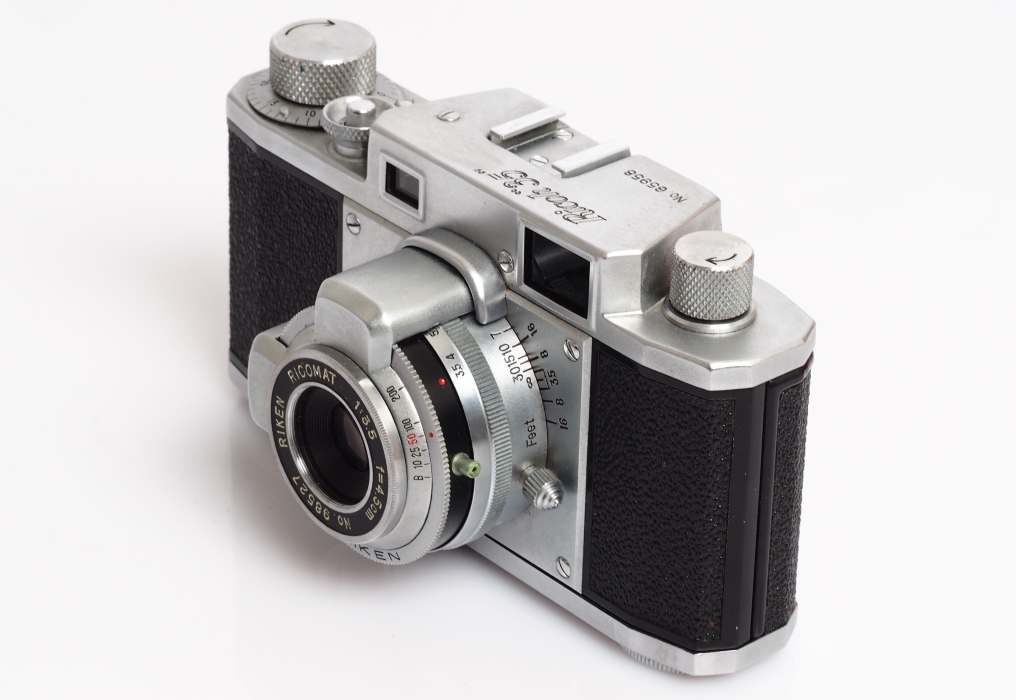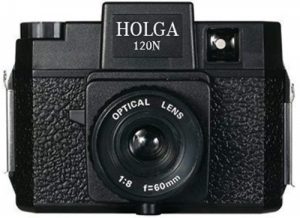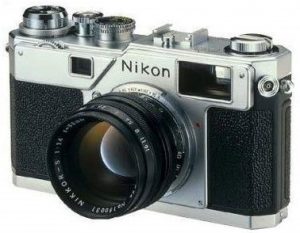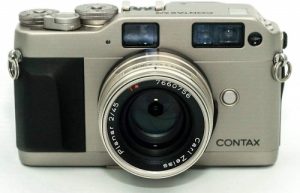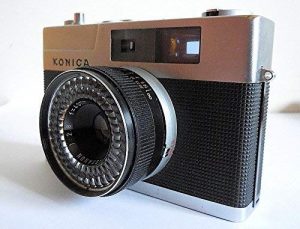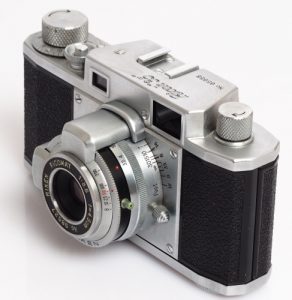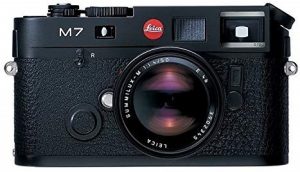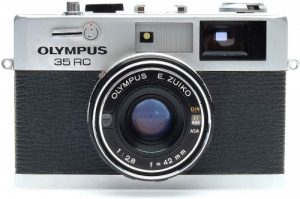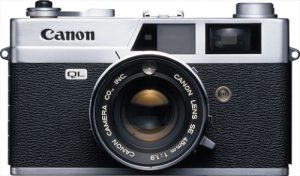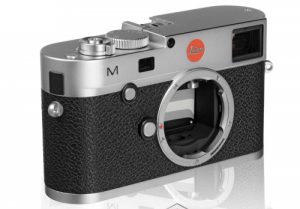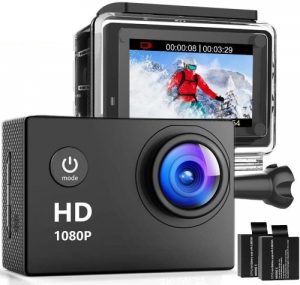For decades, rangefinder cameras have revolutionized the world of photography by allowing users to quickly focus on their subjects and with precision.
However, since the emergence of SLRs and DSLRs, the use of Rangefinder cameras has quickly slowed down probably due to their design and photography functions since their initial release.
But this does not mean that their period of glory is over and that’s why they are still a great choice for most experienced photographers.
In this article, we’ll look at the top ten best rangefinder cameras along with a number of factors that you’ll need to consider before making a purchase. Read on.
Top 10 Best Rangefinder Cameras
1. Holga 120N
The Holga 120N is a classic medium format rangefinder camera that was first introduced to the public in in 1982. Shortly, after its production, the camera became a darling for many due to its controllability, ability to produce dream-like images, and non-dependence on batteries.
However, in 2015 the company ceased its production but it seems to be coming back. Let’s see why the Holga 120N is great choice for photographers around the world.
To begin with, the camera has a simplistic design and is super light, thanks to its plastic body construction. It uses a 120mm medium format film which is pretty much not hard to find.
It also has a 60mm/f/8 plastic lens that produces soft, dream-like images. The plastic lens is further accentuated by the vignetting and random light leaks triggered by the plastic construction.
What’s more, the camera has two shutter speeds (1/100 and bulb), 2 shooting formats (16 6×4.5cm images and 12 6×6 cm images), 2 aperture settings (f/8 and f/11 or “cloudy” and “sunny”), a tripod mount, and a hot shoe adapter.
- Simple and lightweight hence ideal for travel
- Shoot crisp and clear images
- Very affordable camera
- It has a zone focusing system
Cons
- No flash, so not ideal for use in dark settings
2. Nikon S3-2000
The first Nikon S3 was first introduced into the market in 1958. Later on in 2000, the Nikon Corporation introduced the Nikon S3-2000 limited edition model as a way to celebrate the new millennium.
However, only few units were produced making it quite a rare piece and that’s why it’s still coveted by most photographers for its superb performance, great selling value, and timeless appeal.
The camera is noticeably identical in design with the original 1958 model except for a few things like color and serial numbers. It also has top notch ergonomics as well as decently sized control knobs that are easy to access, which make it quite easy to configure.
You can also never go wrong with the S3 2000 when it comes to image quality. It’s Nikkor-S 50mm f/1.4 rangefinder lens captures clear and sharp images that are rich in color. It’s also compatible with a good number of Nikon rangefinder lenses (and Contax lenses) since it uses Nikon S bayonet mount.
What’s more, the camera has both auto and manual focus modes and uses a 35mm cartridge film. It also has shutter speeds of between 1 to 1/1000 seconds which is super-fast and ensures smooth operation. It also has three bright frames lines and a viewfinder that offers 100% magnification.
Pros
- Superb performance
- Sturdy and quality construction
- Top notch ergonomics
- Better image quality
- Compatible with most Nikon rangefinder lenses
Cons
- It has no light-meter
3. Carl Zeiss Contax G1
Most people like to refer to a camera as being unique, while in actual sense they don’t really mean it. The Carl Zeiss Contax G1, however, is a truly “unique” set both in design and performance, which is what separates it from all other 35mm range finder cameras.
Introduced in 1994 as a direct competitor to the Leica M6, the Contax G1 is an autofocusing rangefinder, which means it fits in the realm of purely manual operation and manual focus rangefinder cameras such as the Leica models.
The camera features a highly durable titanium body and a solid aluminum chassis to ensure that its lasts a lifetime. It also uses interchangeable 45mm f/2 Carl Zeiss lenses to ensure that you get clear and crisp images.
Moreover, the camera has a center weighted TTL metering and a real image finder that adjusts the viewing angle when coupled with the selected lenses. Best of all it has an automatic parallax error correction mechanism.
It also has super-fast shutter speeds of 1/2000 seconds and flash synchronization of 1/100 seconds. Film loading, winding, and rewinding are also automatic.
Pros
- Compact rangefinder camera
- Highly durable titanium body for durability
- Interchangeable Carl Zeiss lenses
- Auto-parallax correction
- Auto and manual focus confirmation
Cons
- A bit squinty and small viewfinder
4. Konica EE Matic Camera
The Konica EE Matic rangefinder camera is the first of the EE Matic series cameras that was made by Konica and appeared in 1963. The camera was later replaced by the Konica EE Matic in 1965. However, the camera still remains one of the best range finder cameras ever made.
Although it’s not fancy or feature rich, it excels at the things it does. To begin with, it has an Electric Eye (long for EE), which is a battery-free selenium light meter that encircles the lens. The selenium light meter controls the shutter speed and the aperture through a slider at the bottom of the lens.
What’s more, the Konica EE Matic has a fixed 40mm f/2.8 lens and a shutter with speeds from1/30 to 1/250 of a second. It is said that the 40mm Hexanon lens is so sharp that the company was so proud about it.
The camera also has a focus range of 3-feet and has a filter thread of 49mm. However, it lacks the ASA range of the Konica EE Matic, and only allows 10 to 200 ASA via a dial next to the shutter release.
Pros
- Durable construction
- Vintage camera
- Sharp 40mm f/2.8 Hexanon lens
- Shutter speed range of 1/30 to 1/250
Cons
- Not ideal for taking pictures in low light settings
5. RICOH 35
The Ricoh 35 is a fixed lens range camera that was first made in 1955 by Ricoh. The camera was later replaced by other models in the Ricoh 35 series such as the Ricoh 35 Deluxe in 1956.
As old as it is, this legendary vintage camera model continues to be a great choice for many enthusiastic photographers because of its simple ergonomics, compact size and low profile looks.
Noticeably, the camera has an all metal casing on the outside for protective and durability purposes. On top of that, it comes with an all leather casing for storage.
It also features a 45mm f/3.5 Riken Ricomat lens that produces clear and sharp images. The shutter speed ranges from 1/10 of a second to 1/200 of a second making it a very easy and fun to shoot with.
What’s more, it has a tripod connection that’s positioned on the far right. However, the camera has no built-in meter.
Pros
- Sturdy metal construction
- Leather casing for storage
- 45mm f/3.5 Riken Ricomat lens for sharp images
- Tripod connection
Cons
- No built-in light meter
6. Leica M7
The Leica M7 is a successor of the M6. Born in 2012, the Leica M7 range finder camera is a classic hybrid camera with modern electronic benefits. Similar in design and dimension with the 1954 Leica M3, the Leica M7 is a true testament of how the Leica M series cameras have evolved over time.
The camera features an aperture-priority auto-exposure mode for faster adjustments and control, and two all-mechanical shutter speeds of 1/60th and 1/125th of a second for battery-less performance. It’s also the first camera in the Leica M series with the capability of supporting DX film coding.
The camera is highly dependable and has a wide selection of lenses to choose from ranging from 21-135mm with speeds of as fast as f/1.0. Moreover, it has a faster TTL flash synchronization of up to 1/1000th second when used with Leica-specific Metz flashes.
What’s more, the camera is incredibly quiet and discreet, thanks to the electronically controlled rubberized cloth shutter. It also has a classic viewfinder with magnifications of 0.58, 0.72 (28 mm) and 0.85 (35 mm). The optics of the viewfinder are also multicoated to minimize flare.
Pros
- Adjustable brightness viewfinder
- Quiet and discreet
- Flexible and fast flash capability
- Recognizes DX film coding
- Multicoated optics to reduce flare
Cons
- Poorly designed electrical DX readout
7. Olympus 35RC
Manufactured by the Japanese company, Olympus Corporation in the 1970s, the Olympus 35 RC is one of the smallest and most compact 35mm rangefinder cameras ever made with auto-exposure and manual override settings.
Just like the Leica M7, the Olympus 35RC is reliable, faster to load and shoots faster. It has a dual-blade mechanical leaf shutter with speeds of between 1/15 to1/500 and bulb. The shutter speeds are shown in the finder.
The camera’s finder is also more recessed, which means that it stays clean. It also has a super sharp 42mm f/2.8 lens, a manual rangefinder focus, and an incredibly accurate exposure (manual & auto) system that allows you to take sharp and perfect shots every time.
For perfect automatic flash exposure, the camera employs the Flashmatic system. It is also important to note that the camera is wholly mechanical. This includes the auto-exposure system, which is purely electro-mechanical.
Pros
- Precise manual rangefinder focus
- Great ergonomics
- Small and compact
- Super sharp lens
- Genuine mechanical camera with auto exposure
Cons
- Slower shutter speeds would be better
8. Canon Canonet QL19
The Canon Canonet QL19 is one of the several rangefinder cameras produced by canon between 1961 and 1982. The camera continues to be loved by many due to is sturdy design and ability to produce sharp images.
Compact in design, the Canonet QL19 features a 45mm f1.9 lens and has shutter speed ranges of between 1/4 to 1/500 of a second. With the meter, you can set the camera to shutter priority to set your preferred shutter speed.
The Canon’s Quick Loading (QL) system ensures that film loading is also super-fast. It’s, however, important to note that setting the film speed needs to be done manually between the ISO ranges of 25 ASA and 800ASA.
The camera also comes with a dedicated flash with three different settings that can be accessed on the aperture dial. Practically, the QL 19 doesn’t differentiate much with the QL 17 except for the complex lens design where the QL 17 has 6 elements instead of 5 for that come with the QL19.
- Compact design
- Canon’s quick film loading system
- Manual mode functionality
- Quiet and smooth
- Affordable rangefinder camera
Cons
- Meter doesn’t function in manual mode
9. Leica M Typ 240
The Leica M Typ 240 is one of the world’s best digital rangefinder and full-frame mirrorless cameras. Launched in 2012 to replace the 2009 Leica M9, the Leica M Typ 240 uses the M-System that lets you experience photography in different kind of way.
The model features a 24-Megapixel full-frame CMOS sensor that’s backed by a Leica Maestro image processor that ensures that you get high quality images with smooth color and tonal gradations.
Moreover, it has an ISO sensitivity range of 200-6400 that’s expandable to ISO 100 for working in maximum light settings.
It also supports Full HD 1080p recording in both 24 and 25 frames per second thanks to the dedicated recording button that helps you to instantly switch from stills to video recording.
The camera’s body is resistant to dust and spray water, and the leather trim across the surface ensures that it has a firm and comfortable grip on your hands. It also has a 3-Inch 920k LCD screen that’s scratch resistant to augment the overall durability of the camera.
Other features include a 0.68x optical viewfinder with automatic parallax compensation, and an in-built level gauge that helps in achieving perfect level horizons.
Pros
- Digital rangefinder camera
- 24MP CMOS sensor for high quality images
- Superb design that’s resistant to dust and spray water
- Excellent ergonomics
- Scratch resistant 920k LCD screen
Cons
- Blurry shots at higher magnifications
10. Oaixmn Action Camera
Built for outdoor and underwater photography, the Oaixmn Action Camera is the equipment to take with you. It is not only powerful but durable too.
The camera has a 16MP camera and a 140-degree super-wide lens. You can adjust the angle of viewing and there are multiple angles to select from. With this camera, it’s difficult to miss any background details as you can view them from the 2-inch LCD screen.
Apart from that, the camera has a 1080P/30Fps recording as well as a Sony Sensor. Also, you can connect the Oaixmn camera with your phone via Wi-Fi. This makes it easy to transfer images from the camera to your phone or laptop.
Furthermore, this camera can be used in underwater photography, which means that it’s waterproof. You can easily take pictures at 30m deep making it suitable for watersports like surfing, diving, and swimming.
Included in the package are two rechargeable batteries and accessories for mounting. These batteries can last for three hours each, therefore, increasing your shooting time. The only downside with this camera is that you’ll need to apply silicone grease on the silicon for the camera to maintain its original look.
Pros
- Digital rangefinder camera
- Smartphone compatibility
- Adjustable viewing angle
- Waterproof camera
- Very durable construction
Cons
- Needs silicon grease to keep its original look
Buyer’s Guide
What to Consider When Buying A Rangefinder Camera
Budget
As with buying any gadget, working with a budget is very crucial. Most range finder cameras available in the market today are vintage. As such, their supply is minimal, which means they are high on demand and thus fetch high prices if you happen to land on a new one. It is thus crucial to consider how much money you are willing to spend. Alternatively, you can cut your budget by purchasing a used one from a trusted seller.
Manual focus
When selecting a rangefinder camera, ensure that it has a manual focusing mode. There are number of reasons why manual focusing systems are better than auto-focusing systems. And one of them is speed. With manual focus you are able to capture images instantly with better accuracy (for example in sports) rather than letting the camera seek focus automatically. The other reason is that with manual focus, you are able to circumvent certain conditions such as poorly lit scenes, bright sunlight, or when capturing images of subjects with repetitive and fine details.
Image quality
The image quality produced by a rangefinder camera is highly dependent on the size of the sensor. Most fixed-lens and interchangeable-lens rangefinder cameras use a 35mm sensor. Anything below 35mm will be of low-quality. Therefore consider the size of the sensor and if possible go for a rangefinder camera with an interchangeable lens.
Parallax correction
Parallax is a phenomenon where the image seen on the viewfinder does not accurately match the one recorded on the film. To avoid such mishaps, choose a rangefinder camera that allows parallax correction even when framing close-ups.
Tripod connection
Another important consideration when selecting a rangefinder camera is its weight, size, and ergonomics. If the range camera you are considering to buy is heavier, a tripod can help you circumnavigate the issue of weight and size, and keep the work going.
Frequently Asked Questions
Why are rangefinders better?
First, rangefinder cameras are mirrorless and do not have a mirror shake. They also have the best lenses in the world such as the Zeiss and Leica which are considered by experts to be very sharp and have the best color rendition. Lastly, they are quieter, compact and smaller in size as compared to modern SLR and DSLR cameras.
How does a rangefinder camera work?
A rangefinder displays two overlapping images of an item that is different from a normal camera where you have to look through the lens. Viewfinders are mounted close to the lens for a clearer image.
Why do rangefinder cameras lack a mirror?
The absence of a mirror in a rangefinder camera ensures that there are no disruptions or vibrations caused when taking your pictures. Also, the mirrors absence allows the rear element of lenses to be closer to the focal point.
Why do rangefinder cameras have a larger viewfinder?
The essence of a larger viewfinder is to allow a greater field of vision that helps you in anticipating your shot.
What is shutter priority?
This is an auto exposure system that allows you to select a specific shutter speed after which the camera achieves the correct exposure by adjusting the aperture.
Wrapping up
Investing in a good rangefinder camera can help you capture moments in time for generations. The above are the best rangefinder cameras of all time. Please do not forget to go through the above buying considerations before making a purchase.

